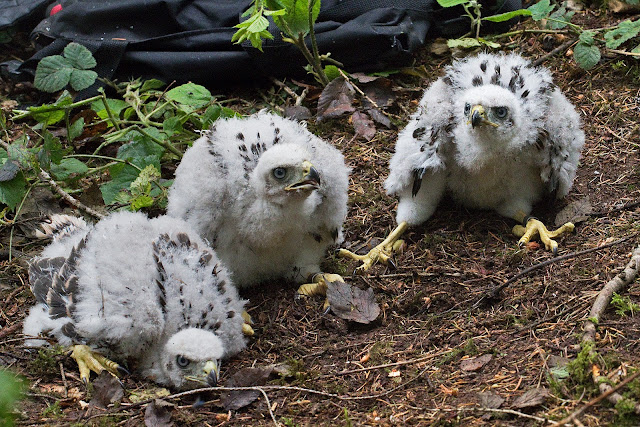I have never been close enough to a Goshawk to be able to get a decent picture so when I had the opportunity to observe a ringing team I leapt at the chance. I had a vision of cuddly little chicks but it did not quite fit the reality. Cute they may be but cuddly they are not. Even at around three weeks they are already showing the large talons, the beak, and the attitude that makes them such a fierce hunter.
 |
| Goshawk chick - singleton in nest three |
I met up with the guys at a remote car park and we set off to investigate the first of six nests. This one had been abandoned as had the second but the last four nests held a total of nine chicks. The Goshawk will lay between one and five eggs but the normal size brood is now three with only the occasional nest holding four.
In the UK the Goshawk has the highest level of legal protection being listed as a schedule 1 bird. The ringing and nest checking helps extend our knowledge of the bird, but the data is also fed to landowners and forestry interests, so that they can ensure that the birds are not disturbed by tree felling or other activities during the nesting season. Many of these nests will have been reported by rangers and game keepers.
A bit of history first. In Britain Goshawk breeding had mostly ceased by the 1880s due to deforestation and persecution. Goshawks were re-introduced by falconers with large numbers being imported in the 1960s and 70s. Many of them escaped or were deliberately released and these established scattered breeding populations. Despite ongoing persecution, from theft of eggs and chicks and the killing of adult birds, they have gradually extended their foothold and there are now estimated to be about five hundred breeding pairs in the country.
Moving on to the birds, the first problem was the walk into the nests, I am not quite as fit as I thought. The second is getting to the nest. They can be as low as ten to twelve metres but the four trees climbed today had nests at over twenty metres with the highest being twenty seven metres. For this you need someone that knows what they are doing.
 |
| Rob on the way up |
 |
| and nearing the nest |
The Goshawks favour Larch but will also nest in pine trees. They will return to the same nest site year after year often reworking the existing nest but occasionally starting a new nest in the same area. The nest is substantial and needs good support. They are usually built at the bottom level of the canopy giving the parents access routes under the trees. The one above is easy to see against the open sky but in denser woodland even a large nest can be hard to spot.
 |
| Three Chicks from nest four |
The chicks age is determined by measurement of the length of the primary wing feathers. With the females being larger and heavier than the males, the width of the tarsus and the weight of the chick enable the sex to be determined. This is usually done after 18 to 20 days although it is often evident before this time.
 |
| Two males at the back with female at the front - Although born last the female is already twenty percent heavier than either of the males. |
 |
| but the males tend to be more feisty at this early age |
Nest five was a bit unusual. It appeared to have a male sitting on the nest. It is possible that the female was away feeding, but the male would normally bring food to her on the nest. When the two chicks were brought down it was clear that one was not getting enough food.
 |
| These two chicks are about the same age but the one on the left is much lighter in weight. It does however, have a full crop of food so there is a good chance that it could survive. |
It is possible that something has happened to the female and that the male is attempting to fledge the chicks by itself. Unfortunately, despite their legal status, the Goshawks are still persecuted and if the female has found an easy source of food picking up Pheasant poults on one of the local shoots it could have run into trouble.
Nest six was at twenty seven metres but it was the only one where you could get a partial view into the nest from higher up the hill. This again held three chicks.
 |
| Do you get the impression that he is eyeing me up as a food source? |
 |
| Nest six three chicks |
A fantastic day out and so much learnt about this wonderful bird. A nice picture of a female, sitting out in the open, would have really finished off the blog on a high point but despite seeing a number of males and females none of them offered picture opportunities.
I think I could now spot a female Goshawk, but, with the fleeting views that you get, I am still not sure that I could separate out the male from a Sparrow Hawk.
My thanks to Jerry for allowing me to tag along, to Rob for all the climbing, and to Scott and Natalie who are training to take on the role in the future.




No comments:
Post a Comment